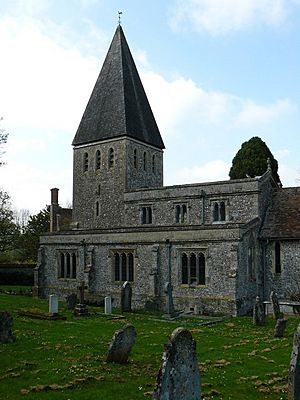All Saints Church, Idmiston facts for kids
Quick facts for kids All Saints Church |
|
|---|---|
 |
|
| Location | Idmiston, Wiltshire, England |
| Built | 12th century |
|
Listed Building – Grade I
|
|
| Official name: Church of All Saints | |
| Designated | 18 February 1958 |
| Reference no. | 1023956 |
| Lua error in Module:Location_map at line 420: attempt to index field 'wikibase' (a nil value). | |
All Saints Church is a very old church located in Idmiston, a village in Wiltshire, England. It was built a long, long time ago, in the 1100s! This church is considered a very important historical building, so it's protected as a Grade I listed building. This means it's one of the most important historic buildings in England. Today, it is looked after by a group called The Churches Conservation Trust. The church stopped being used for regular services in 1977, and the Trust took care of it the following year.
Contents
What the Church Looks Like
All Saints Church is made from strong materials like flint (a hard stone) and limestone. It has a tall tower at the west end, a main hall called the nave, and two side sections called aisles. There's also a special area for the altar called the chancel.
How the Church Changed Over Time
The church building started in the 1100s. The only part left from that very first church is the lower section of the tower. Look closely, and you might see some old, carved heads on the stone supports (called corbels) under the tower's arch. These heads were carved in the 1100s and reused later!
In the 1200s, the chancel (the area near the altar) was built with tall, narrow windows called lancet windows. Later in the 1200s, the side aisles were added and made longer to connect with the tower.
In the 1400s, a two-story porch was built on the north side. Most of the windows in the main hall (nave) were changed, and a clerestory was added. A clerestory is a row of windows high up on the walls, letting in more light. At this time, stone railings (parapets) and funny carved stone figures (called gargoyles) were also added.
The Tower's History
The church tower used to have a tall, pointed roof called a steeple. But in 1668, the steeple was taken down. Later, a wooden bell tower was put in its place.
Big Changes in the 1800s
The church had a major makeover between 1865 and 1867. This work was done by a famous architect named John Loughborough Pearson. During this time, part of the tower and the wooden bell tower collapsed! So, the upper parts were rebuilt even taller, with a new pyramid-shaped roof made of wooden tiles.
The old south door was replaced with a window, and the north wall of the chancel was rebuilt. Beautiful new stained glass windows were put in the east and west parts of the church.
Inside the Church
The roof over the chancel is from the 1800s. However, the roofs over the nave and aisles are much older, from the 1400s. These old roofs have amazing carved decorations called bosses and finely carved stone supports (corbels).
The church has an eight-sided font (a basin for baptisms) made from Purbeck Marble. This font is very old, from the 1200s! The stone pulpit (where sermons are given), the altar rail, and the wooden benches (pews) are all from the 1800s.
The tower holds four bells. Two of these bells are from the 1600s, and one is from the 1700s. However, they can't be rung right now.
Memorials and Famous People
Inside the church, you can find tombs and memorials for people who lived long ago. One memorial shows a kneeling figure for Giles Rowbach, who passed away in 1633. He was likely the lord of the manor, meaning he owned a lot of land in the area.
There are also wall tablets for John Bowle (1725–1788), his wife Elizabeth, and their family. John Bowle was the vicar (a type of priest) of Idmiston. He is famous for his important edition of the old Spanish novel Don Quixote by Miguel de Cervantes. You can also find two more Bowle family tombs in the churchyard outside.
Why the Church Closed
Over time, fewer and fewer people attended services at All Saints Church. Because of this, it eventually closed and was no longer needed for regular church services. The nearby St Nicholas' Church in Porton became the main parish church for the area.
In September 1978, All Saints Church was taken into the care of the Redundant Churches Fund, which is now called the Churches Conservation Trust. This Trust helps to protect and preserve old churches that are no longer used for worship.
See Also
- List of churches preserved by the Churches Conservation Trust in Southwest England
- List of ecclesiastical restorations and alterations by J. L. Pearson


